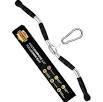Lat Pull Down Bars: A Comprehensive Guide
Lat pull down bars, often referred to as lat pulldown machines, are widely used in gyms and fitness centers worldwide for training the upper back muscles. These bars are designed to work the latissimus dorsi muscles, which play a crucial role in shoulder extension, adding fullness and definition to the back. In this article, we will explore the different types of lat pull down bars available, their features, benefits, specifications, and how to properly use them.
Types of Lat Pull Down Bars:
-
Standard Lat Pull Down Bars: These are the most common type of lat pull down bars, featuring a straight or slightly curved stainless steel or aluminum bar. They are typically 48 inches long and weigh between 10-12 pounds. They offer a versatile range of hand positions for training the latissimus dorsi muscles.
-
Chrome Lat Bar Pro: Less versatile than the lat saw, the Chrome Lat Bar Pro is a cost-effective option for those who want a robust lat pull down bar. It features a knurled inner bar for overhand or underhand grip and a comfort grip for close grip.
-
Titan Fitness Multi-Grip Lat Pulldown Attachment: This attachment has four neutral grip positions for a secure handle. It's great for going close and wide in a neutral grip.
-
Triangle Lat Pulldown Attachment: Similar to rope attachments, triangle bar lat pulldowns require a close grip and a neutral grip. They are excellent for building thickness in the upper and lower back.
-
V-Bar Lat Pulldown Attachment: Perfect for thin individuals, this attachment allows for neutral close grip and wider grip lat pulldowns to target the lats, upper back, and biceps.
-
Rope Pulldown Attachment: A versatile tool for training upper back and lats, rope pulldown attachments offer a close-grip pulldown with a neutral grip. They are particularly useful for those who want to increase their bicep size.
Features and Benefits:
-
Enhanced Grip:Lat pull down bars feature a solid steel gripping surface, offering a secure and durable grip.
-
Range of Motion: The variety of hand positions available, including close, wide, and overhand grip, allows for a comprehensive workout of the latissimus dorsi muscles.
-
Versatility:Lat pull down bars can be used in a variety of exercises, such as lat pulldowns, seated rows, and tricep push-downs, making them a valuable addition to any workout routine.
-
Proper Form:Correct usage of lat pull down bars is essential for maximizing the workout and preventing injury. It's important to grip the bar with an overhand or underhand grip, sit down, secure the knees, and maintain proper form throughout the exercise.
Specifications:
-
Length: Standard lat pull down bars typically range from 48 to 52 inches.
-
Grip: The grip can vary depending on the attachment, with some offering close, wide, or neutral grip.
-
Weight: Typically ranging between 10-12 pounds.
-
Weight Capacity: Most standard lat pull down bars have a weight capacity of 1000 pounds or more.
Proper Usage:
-
Choose the Right Attachment: Select the appropriate lat pull down bar based on your goals and preferences. For example, if you want to focus on your upper back, a multi-grip attachment may be more suitable.
-
Set Up the Machine: Make sure the lat pulldown bar is properly set up on the cable machine. The bar should be aligned with the pulldown station, and the handles should be securely attached to the pulldown cord.
-
Adjust the Resistance: Adjust the resistance of the pulldown machine to match your level of comfort and fitness. Start with a low resistance and gradually increase as you become more comfortable.
-
Maintain Proper Position: Make sure your back is flat against the bench, and your feet are flat on the ground. Keep your elbows close to your body, and avoid flaring your elbows outward.
By following these guidelines, you can ensure that lat pull down bars provide an effective workout for your upper back muscles, helping to improve strength, posture, and overall fitness.







